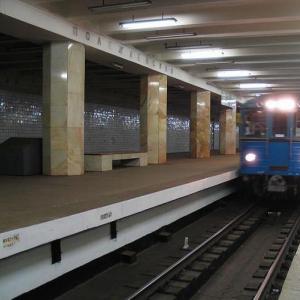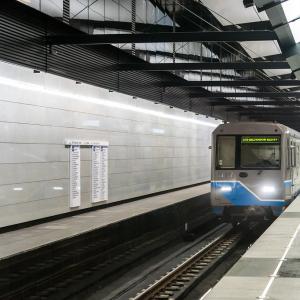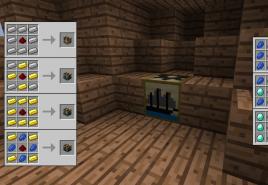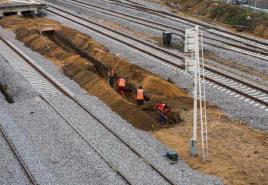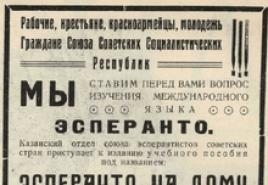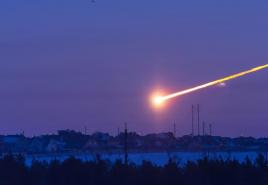Which MCC stations are working now. Mkzhd: map of stations
It is a railway ring laid along the outskirts of Moscow. In the diagram, the small ring of the MKZD railway looks like a closed line. The construction of the ring was completed in 1908. Until 1934, the railway was used for freight and passenger traffic, and after 1934 - only for freight. It is a connecting link between ten federal railway lines leaving the city in all directions. Since September 2016, it has also been used for passenger intracity transportation related to the operation of the Moscow Metro, which was reflected in the scheme of Moscow Ring Railway stations.
Modern reconstruction of Moscow Railway
From 2012 to 2016, the Moscow Ring Railway was adapted for domestic passenger traffic, which led to a significant change in the scheme of the Moscow Ring Railway. The work was carried out at federal funds, as well as at the expense of Russian Railways, private companies and the Moscow government. In the process of reconstruction, the railway tracks were replaced with new ones, bridges were overhauled, electric train stopping points were built, and another track intended for freight traffic was laid. At the end of 2016, the work was almost completed.
In total, 31 stopping stations were reconstructed (the scheme of the Moscow Ring Road with stations under construction is presented above). For each station, an individual project was developed, platforms were built.
Launch of the first electric trains
The first launch of an electric train in order to check the readiness of the railway was carried out in May 2016 on one of the sections of the Moscow Ring Road, and in July 2016, after construction was completed, along the entire length of the railway. The main electric train running along the route was the ES2G Lastochka. Ordinary Russian-made electric trains were also involved. With their use, there were some problems associated with the discrepancy between the width of the wagons and the electric locomotive of classical models with the distance between the tracks and the platform on the Moscow Ring Road. As a result, the platform at the Streshneva station even had to be shifted a little to the side.

The first passenger electric train ran along the line on September 10, 2016, after which passenger trains began to run regularly. The movement of freight trains has been reduced, especially during the daytime, when electric trains are actively running. The line is also used for the movement of individual long-distance trains that bypass Moscow. The movement of excursion trains on locomotive traction was stopped.
Infrastructure and scheme of Moscow Ring Road
The railway ring of the Moscow Ring Road includes 2 main railway lines belonging to the category of electrified. Another third railway line runs along the north of the ring, which is used for freight traffic. The total length of the railway ring is 54 km. Some sections of other tracks are still not electrified.
The MKZD scheme is designed in such a way that it has connecting branches that allow trains to move between the ring railway and the radial branches of the federal railways. They consist of either one or two tracks (see the MKZD transfer map). Not all of them are equipped with feeding power lines. From the freight tracks of the railway ring there are branches to industrial production facilities. There is also one branch for connection with the tram depot.
In total, there are 31 operating platforms for domestic passenger traffic and 12 freight stations on the MKZD scheme. There is 1 tunnel 900 m long.
Stations and platforms on the MKZD scheme
The stations were founded in 1908 and were originally used for freight traffic. Separate stations were located between them.
In the inner part of the railway ring there are classical stations that are not used now with station-type buildings built at the beginning of the 20th century. Previously, the railway track running along them was used for passenger transportation. Modern stations can be seen on the diagram of the Moscow Ring Road with stations under construction.
On the outside of the Moscow Railway, entrances for parking of freight trains and buildings intended for railway work were built. All this is used to form freight trains.
In 2017, the total number of stations in use (see the scheme of stations of the Moscow Ring Road) amounted to 12 units. Of these, 4 are located on sections of branches from the Moscow Ring Road. These include: Novoproletarskaya, Northern Post.

There are 31 stopping points for urban electric trains on the railway ring. These stations are passenger platforms that were built between 2012 and 2016 during the modern reconstruction of the Moscow Ring Railway. Unlike stops belonging to the radial main lines of the railway, these have the status of intracity and are equipped accordingly. They work as public transport stops with the same tickets for them.

Bridges on Moscow Ring Road
In total, there are 6 active bridges, 4 of which cross the Moscow Ring Road. Also, 32 highways and railways cross the Moscow Ring Road.
Movement along the Moscow Ring Road
At the moment, movement along the Moscow Railway is carried out by electric trains ES2G "Lastochka". It consists of 5 passenger cars of a modern design, and with a coupled version - of 10 cars. In the future, the use of other locomotives (domestic production) is not excluded.

Diesel locomotives are still mainly used for freight transportation. However, the main railway lines are now electrified and allow the use of electric locomotives for transit traffic. Thanks to this, it is possible to move passenger and freight trains from one transit radial line of railways to another.
So, I decided not to shelve this matter, and yesterday, after work, I joined. I didn’t drive along the full ring, there was no time, but I mastered three quarters of it - from Vladykino to Izmailovo.
Well, what can I say? So far, it is obvious that this is an attraction of pure water, approximately like the Moscow monorail immediately after its opening, which was then officially working "in excursion mode." Only the monorail was paid, but the MCC was not, which is what the vast majority of its passengers use. But first things first.
What we liked: Trains! You can laugh at me, but yesterday I rode the "Swallow" for the first time. Very smooth acceleration and quiet, in terms of sound, movement. On the move, you hear not the sound of traction engines, not the howling of gears, not the knock of compressors - but only the grinding of the wheel flange against the rails in curves. Well, even at high speed, the wobbling of the wagon is felt. But, by and large, in comparison with those ER1 ED4M, which we ride - heaven and earth. In general, comparing Siemens Desiro Rus and the crafts of the Demikhovsky plant is like comparing black sturgeon caviar with capelin caviar.

Navigation at the stations is fully present (however, in some places they did not replace the plates with the original names, which were changed during the construction process). But, in general, everything is clear and intelligible:


Escalators work at all stations where I have been - which is important, considering that the route of the District Railway, historically, is located on high embankments for almost its entire length.
What did not like: The whole MCC is still very, very raw. It’s good to finish it for at least another two months - but we have assault and window dressing at the forefront, so ... Many stations have not completed the actual exits to the city - for me, for example, to get to the platform from Dmitrovsky highway, I had to walk past the Okruzhnaya platform, because the entrance to it is open only from the inside of the ring, and walk to the next Vladykino station. There is a transition to the outer side on Okruzhnaya - but it has not yet been completed, and is closed. The "wild" crossing that used to be here was blocked with fences - however, the citizens have already made holes in them ... you have to cross the piece of iron, but go around a kilometer - no fools. The same thing happened at the exit - and I went out to Izmailovo: direct access to the Partizanskaya metro station is still being completed, so citizens are forced to use the only exit towards Tkatskaya Street, and make a detour under the overpasses of the MK MZhD and the fourth ring. Three hundred meters in a straight line, and six hundred along the existing route - there is a difference.
Secondly, as many have noted, there really are not enough informant announcements on which side the platform to which the train arrives is located. On the MCC, the platforms are mainly coastal, but about a quarter are island ones. Until the train pulls up directly to the platform, it is not visible. As a result, getting out rush from one side of the car to the other. Over time, of course, they will remember where everything is located, and they will get used to it - as they are already accustomed to pressing the buttons on the doors so that they open - but now this is noticeably lacking.
The third is the name. What means Moscow Central Circle? And where is the Moscow non-central ring? There was a normal name - the Moscow District Railway, historical, and understandable to everyone: BMO is BMO, it is in the region, and Okruzhnaya is in Moscow. But no. EM CE KA. The Central Committee of some EM. The combination of three consonants is terrible.
Well, the fourth thing I don't like about the MCC - but this is my personal IMHO: the organization of a purely ring traffic. MK MZhD has a connection with all radial railway lines of the Moscow junction, including those that do not have a through diametrical passage: Kazansky, Kievsky, Paveletsky and Yaroslavsky. Nothing prevents some of the trains from these directions from running not to their dead-end stations, but in transit through the ring to another radius. Part, not all - let one train out of five - ten. Especially considering the desire of the Moscow Region authorities and Russian Railways to increase the pairing of suburban electric trains under the slogan of turning them into some kind of "light metro" (the term, in this case, is absolutely illiterate, but I will use it, in relation to the situation). Yes, this will complicate the scheduling, make it necessary to match the schedules of different directions - but nothing is impossible. After all, the New York subway has been operating on the same route pattern for many decades. Of course, someone will object to me that this is a utopia - my dears, about ten years ago, passenger traffic itself along the Small Ring was also considered a utopia. However...

Will they use: Definitely, they will. First of all, those who work or live within walking distance of the ring stations. I myself, if I still lived on Kutuzovsky Prospekt, would absolutely use it - my home is right opposite the platform:

With transfer trips it is much more difficult - so far, convenient transfers to the MCC can be counted on the fingers of one hand - "Leninsky Prospekt" - Gagarin Square, "Kutuzovskaya", "Vladykino", "Cherkizovskaya" - Lokomotiv - well, perhaps that's all. With transfers to trains and ground transport, it is even more difficult. Perhaps, when all this is brought in accordance with the plans, the passenger flow will settle down. Again, using the ring for travel is convenient only if the route that runs through it is a quarter, a maximum of a third of the length of the ring. If more, then it is much more convenient to drive in a straight line, especially since there is almost always such an opportunity. Well, now 80-90% of passengers are exclusively curious citizens. Including transport freaks - freaks, loudly, for the whole car or platform, discussing the advantages and disadvantages of electric trains of the ES2G class compared to trains of the ET2M series, for example :) But someone has already fully appreciated the innovation, and uses it in a direct - transport - destination:

True, these are mostly young people, who are seven miles away from the transfer - not a detour :) Interestingly, I noticed that there are much more passengers on trains following the inner side of the ring than those that go along the outer one. Well, and - for me personally, the MCC is neither to the village nor to the city, at least at the present time.
About the views from the train window: Let's be objective: since the construction of the District Railway in 1908, it has been the center of attraction for industrial zones that have been built around it for seventy (I repeat: SEVENTY) years. And overnight they, and the entourage that accompanies them, will not go anywhere, even though they try to bashfully cover them with fences:

No, I do not argue that the railway also passes by quite beautiful places in Moscow: in Luzhniki, for example, this is the Novodevichy Convent, and the Luzhniki sports complex itself; in Izmailovo - the hotel complex of the same name, and the Izmailovo Fair, with its popular Kremlin; post-war development in the area of the Oktyabrsky field; beautiful views open up from the bridges across the Moscow River, the Belokamennaya station is generally located in the forest, and not just in the forest, but in the Losiny Ostrov National Nature Park; and someone likes the skyscrapers of the City:


But, in eighty percent of cases, the surrounding landscape from the window will look like this:
So if you love aesthetics ebeney- industrial zones, garages, and multi-level transport interchanges - you will certainly enjoy a trip around the MCC. Just hurry - with the current pace of Moscow urban planning, they will soon be exhausted for the most part.
My impressions. Of course, I liked it more than I didn’t like it, judging by a five-point scale :) Already one thing - a ride on an electric train along the legendary District Railway, on which passenger trains have not run for more than eighty years - is worth a lot. Of course, the jambs are very striking. But there is no doubt that they will be corrected. The main thing is not to forget about the little things.

It is good that the ring was not turned into a purely passenger one, a complete analogue of the metro, as some radical comrades suggested: after all, the original purpose of the District Railway - to connect all Moscow railway radii - is a strategic thing, and should have remained untouched. Again, variety for the railroad fans ;)

More from what I've seen. The MCC has its own Moscow time:

Business center station, with its vigorous green color:

The canopy over the platform is connected to the walls in such a way that during rain, water will be poured into the station. Is that how it's meant to be?

When I was at the Kutuzovskaya station, two hard workers dragged, right across the tracks, some hefty electric box, and threw it onto the platform, in its narrowest place. A minute later, the Swallow arrived on the same path, disembarking passengers who had to step over this box, or squeeze between it and the wall. That is, with ensuring the safety of both employees and passengers at the MCC, so far, complete seams. I would like to hope that this will not lead to serious consequences.
Something like that. Of course, I plan to drive around the MCC more thoughtfully, and during daylight hours. And then in the dark around you can’t see anything at all :)

In the meantime, I voiced my first impressions from his visit. So all of the above is just my personal subjective opinion.

Yes, and: a note for those who are in the subject;) In my passport in the column "Place of birth" is written "city of Moscow". And on my father's side, I'm a Muscovite in the third generation;)
ENGLISH VERSION OF THIS BLOG. Add as a friend My travel project http://usadboved.ru My telegram…
In Bogoroditsk, final preparations are underway for the launch of water into the manor ponds
February is on the calendar, and outside the window is dampness and dirt, which is abnormal for the last winter month. But despite the difficult weather...
 What's in the feeder? How to feed birds and other interesting facts about birds - on the Ecoelectric train excursion
What's in the feeder? How to feed birds and other interesting facts about birds - on the Ecoelectric train excursion
It would seem: what do we not know about feeding birds? After all, almost every family in the country has a birdhouse! However, the science of proper bird feeding is like...
Manor Zakharovka, Lipetsk region, Volovsky district
We often travel around the Lipetsk region and have already made virtual tours of many estates in this region. But with the Volovsky district, alas, ...
The GREBNEVO estate at the beginning of 2020: changes, furnishings, plans
Going through my photo archives, I suddenly remembered that the last time I was in the Grebnevo estate back in 2017! During this time, the estate, which after…
Kulikovo Pole, temple of Sergius of Radonezh, Tula region
Defender of the Fatherland Day! I thought for a long time about how I would congratulate my readers and colleagues on this day. And I decided that all words and wishes are easy ...
 Blog tour to the Ivanovo region: who wants to join?
Blog tour to the Ivanovo region: who wants to join?
Colleagues: journalists, bloggers, PR people, representatives of monument protection authorities, volunteers and everyone who is interested in the topic of protection, promotion and…
Launch Stages
The opening of the Moscow Central Ring (MCC) took place on September 10, 2016. At the first stage, 24 stations will be available for passengers, and seven more MCC platforms will open in December. RIAMO correspondent learned how to use a new type of urban transport.
The opening of MCC stations will take place in three stages.
The first one is scheduled for September 10, already this Saturday 24 stations will be put into operation: Okruzhnaya, Likhobory, Baltiyskaya, Streshnevo, Shelepikha, Delovoy Tsentr, Kutuzovskaya, Luzhniki, " Gagarin Square, Krymskaya, Upper Boilers, Vladykino, Botanical Garden, Rostokino, Belokamennaya, Rokossovsky Boulevard, Lokomotiv, Falcon Mountain, Enthusiasts Highway, Nizhegorodskaya, Novokhokhlovskaya, Ugreshskaya, Avtozavodskaya and ZIL.
In December 2016, 7 more stations will become available to passengers: Koptevo, Panfilovskaya, Zorge, Khoroshevo, Izmailovo, Andronovka and Dubrovka.
And in 2018, the construction of warm transitions will be completed: it will be possible to make transfers without going outside. In total, 350 transfers will be available for passengers, so travel time should be reduced by 3 times.
2
Fare
From September 10 to October 10, 2016, travel to the MCC will be free for everyone. Some of the turnstiles will be open, while others will automatically open when you approach them. So, tickets will need to be applied to the turnstile only in the transitions to railway stations and in the subway.
After October 10, any Moscow Metro travel cards (Troika, Ediny, 90 Minutes), as well as social cards, will be used to enter the MCC station. Within 90 minutes from the moment of ticket validation, the transition from the metro to the MCC and back will be free. It is also possible to pay for travel by credit cards.
3
MCC schemes
Three variants of MCC schemes have been developed for passengers. The first one, in addition to metro lines and MCC stations, indicates the stages of opening stations and crossings, the distance between transfer stations and the time it takes to transfer.
The second version of the scheme will help passengers of electric trains orient themselves: the map shows railway stations, existing metro lines, as well as MCC stations and "warm" transfers to the metro.
The third scheme shows the stops of urban ground transport near the MCC stations, as well as the interval of its movement during rush hour. For example, from the Luzhniki platform of the Moscow Central Circle, you can go to the Sportivnaya metro station in 2 minutes. Buses 806, 64, 132 and 255 run regularly there, so getting to the right place is not difficult.
In addition, the map shows all the main attractions of the city, forest parks and nature reserves. Many of them are within walking distance of the MCC, for example, the Losiny Ostrov park and the Vorobyovy Gory nature reserve.
4
Transplants
The MCC is integrated into the Moscow public transport system with the possibility of transferring to the metro, Moscow Railway trains and surface public transport.
From September 10, it will be possible to transfer from the MCC to the metro at 11 stations (Business Center, Kutuzovskaya, Luzhniki, Lokomotiv, Gagarin Square, Vladykino, Botanical Garden, Rokossovsky Boulevard, "Voykovskaya", "Highway Enthusiasts", "Avtozavodskaya"), by train - by five ("Rostokino", "Andronovka", "Okruzhnaya", "Business Center", "Likhobory").
By the end of 2016, the number of transfer hubs will increase to 14 and 6, respectively, and in 2018 there will be 17 transfers from the MCC to the metro and 10 to the train.
To make a metro-MTC-metro transfer for free (within 90 minutes), you need to attach a metro travel document to the turnstile with a special yellow sticker at the entrance to the MCC station.
Passengers who plan to travel only along the MCC or are going to make one metro transfer - MCC or vice versa can apply tickets to any turnstiles, including those without yellow stickers.
If you missed 1.5 hours, you must pay the fare again when transferring.
5
Trains and intervals
New luxury trains Lastochka with a capacity of 1,200 people will run at the MCC. Their maximum speed is 160 kilometers per hour; they will travel along the MCC at an average speed of 50 kilometers per hour.
The trains are equipped with air conditioning, dry closets, information panels, free Wi-Fi, sockets and bike racks.
The cars will open manually: to enter or exit, you will need to press a special button installed on the doors. The buttons will be active (green illumination) only after the train has stopped on the platform, at other times the doors will be locked for safety reasons.
In the morning and evening peak hours, the traffic interval will be only 6 minutes. The rest of the time, "Swallow" will have to wait from 10 to 15 minutes.
6
Renewal (activation) of travel cards
In order to get to the MCC with 90 minutes, Unified for 20, 40 and 60 trips, Troika, bought or replenished before September 1, 2016, you need to renew them. To do this, you can contact the metro or monorail ticket office, as well as the metro passenger agency (Boyarsky per., 6) or the Moscow Transport service center (Staraya Basmannaya st., 20, building 1).
Holders of the Strelka card for traveling by train must exchange it at the metro ticket office for a card with the Troika application.
Activation is carried out without changing the balance of trips and the validity of the ticket, while the new reprogrammed travel documents will allow free transfers from the metro to the MCC and back.
Also, the Troika electronic card can be updated independently by topping up the balance at ticket machines at stations, on the troika.mos.ru website, via SMS or at payment terminals. As for social cards, their activation is not required.
7
Help and navigation
You can find out detailed information about ticket renewal, transfer hubs and navigation on the MCC from consultants at the entrance to the ring metro stations or at metro stations adjacent to the MCC. Volunteers will also help passengers navigate the new transport. A special mobile application is also being developed, with the help of which it will be possible to choose the best route.
Here you can see new convenient routes through the MCC.
You have probably already paid attention to the new scheme that appeared in the Moscow metro on December 21, 2015. The scheme now has a new ring with an abbreviation that is not quite usual for the metro. MKZHD - Moscow Ring Railway - is another ring in Moscow, which is designed to unload the ever-growing passenger traffic of the capital.
Why is the railway line diagram present on the metro map?
It is explained simply. MKZHD, scheduled for launch in autumn 2016, will form a single transport hub with the Moscow Metro. Another type of land transport will appear in Moscow - city train, closely linked to the metro infrastructure and existing railway stations. This type of public transport is widely used in major cities around the world.
Of the 31 stations of the Moscow Ring Railway, at 17 it will be possible to transfer to the metro, and practically without going outside, since the crossings connecting the railway stations and metro stations will be covered and form a single transport terminal - Transport Interchange Hubs (TPU). At 10 stations there will be transfers to other railway stations.

The fare will be the same as in the subway. You don't have to pay anything for a transfer.
Trains of a new type from 5 to 10 wagons with a convenient tambourless design will run along the Moscow Ring Road. Estimated capacity will be at least 1250 people. The head cars will be equipped with seats for persons with disabilities and a system for boarding and disembarking people in wheelchairs.
The trains will also have WI-FI with free internet, tinted windows, information boards in different languages, and a climate control system. The head car will have a toilet for passengers and the locomotive crew.

At the stations, parking lots will be created for motorists changing to electric trains.
And finally, the best part - planned traffic interval - 6 minutes!
January 2016
The Moscow Central Ring of the Moscow Central Circle will be the official name of the new transport system that will be opened today. Adjustments have been made to the intervals of trains - 15 minutes, and during peak hours - 6 minutes. Of the 31 stations, 26 are opening today - Vladykino, Botanical Garden, Rostokino, Belokamennaya, Rokossovsky Boulevard, Lokomotiv, Izmailovo, Enthusiasts Highway, Andronovka, Nizhegorodskaya, Novokhokhlovskaya, Ugreshskaya, Avtozavodskaya, ZIL, Verkhnie Kotly, Krymskaya, Gagarin Square, Luzhniki, Kutuzovskaya, Business Center, Shelepikha, Khoroshevo, Streshnevo, Baltic, Likhobory, Okruzhnaya. The remaining 5 - Dubrovka, Zorge, Falcon Mountain, Koptevo and Panfilovskaya - will open at the end of the year.

